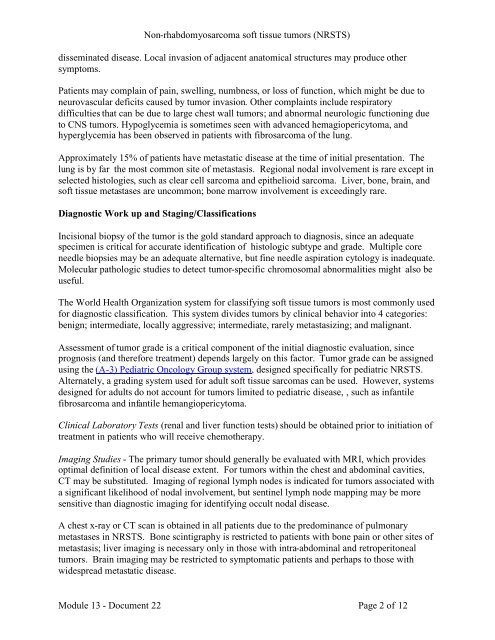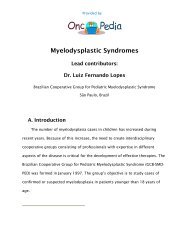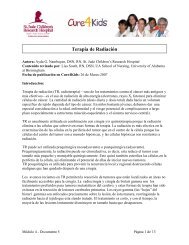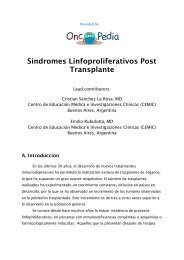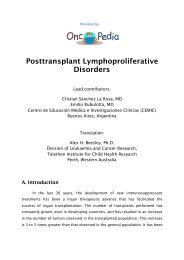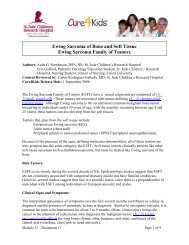Non-rhabdomyosarcoma soft tissue sarcomas (NRSTS)
Non-rhabdomyosarcoma soft tissue sarcomas (NRSTS)
Non-rhabdomyosarcoma soft tissue sarcomas (NRSTS)
You also want an ePaper? Increase the reach of your titles
YUMPU automatically turns print PDFs into web optimized ePapers that Google loves.
<strong>Non</strong>-<strong>rhabdomyosarcoma</strong> <strong>soft</strong> <strong>tissue</strong> tumors (<strong>NRSTS</strong>)<br />
disseminated disease. Local invasion of adjacent anatomical structures may produce other<br />
symptoms.<br />
Patients may complain of pain, swelling, numbness, or loss of function, which might be due to<br />
neurovascular deficits caused by tumor invasion. Other complaints include respiratory<br />
difficulties that can be due to large chest wall tumors; and abnormal neurologic functioning due<br />
to CNS tumors. Hypoglycemia is sometimes seen with advanced hemagiopericytoma, and<br />
hyperglycemia has been observed in patients with fibrosarcoma of the lung.<br />
Approximately 15% of patients have metastatic disease at the time of initial presentation. The<br />
lung is by far the most common site of metastasis. Regional nodal involvement is rare except in<br />
selected histologies, such as clear cell sarcoma and epithelioid sarcoma. Liver, bone, brain, and<br />
<strong>soft</strong> <strong>tissue</strong> metastases are uncommon; bone marrow involvement is exceedingly rare.<br />
Diagnostic Work up and Staging/Classifications<br />
Incisional biopsy of the tumor is the gold standard approach to diagnosis, since an adequate<br />
specimen is critical for accurate identification of histologic subtype and grade. Multiple core<br />
needle biopsies may be an adequate alternative, but fine needle aspiration cytology is inadequate.<br />
Molecular pathologic studies to detect tumor-specific chromosomal abnormalities might also be<br />
useful.<br />
The World Health Organization system for classifying <strong>soft</strong> <strong>tissue</strong> tumors is most commonly used<br />
for diagnostic classification. This system divides tumors by clinical behavior into 4 categories:<br />
benign; intermediate, locally aggressive; intermediate, rarely metastasizing; and malignant.<br />
Assessment of tumor grade is a critical component of the initial diagnostic evaluation, since<br />
prognosis (and therefore treatment) depends largely on this factor. Tumor grade can be assigned<br />
using the (A-3) Pediatric Oncology Group system, designed specifically for pediatric <strong>NRSTS</strong>.<br />
Alternately, a grading system used for adult <strong>soft</strong> <strong>tissue</strong> <strong>sarcomas</strong> can be used. However, systems<br />
designed for adults do not account for tumors limited to pediatric disease, , such as infantile<br />
fibrosarcoma and infantile hemangiopericytoma.<br />
Clinical Laboratory Tests (renal and liver function tests) should be obtained prior to initiation of<br />
treatment in patients who will receive chemotherapy.<br />
Imaging Studies - The primary tumor should generally be evaluated with MRI, which provides<br />
optimal definition of local disease extent. For tumors within the chest and abdominal cavities,<br />
CT may be substituted. Imaging of regional lymph nodes is indicated for tumors associated with<br />
a significant likelihood of nodal involvement, but sentinel lymph node mapping may be more<br />
sensitive than diagnostic imaging for identifying occult nodal disease.<br />
A chest x-ray or CT scan is obtained in all patients due to the predominance of pulmonary<br />
metastases in <strong>NRSTS</strong>. Bone scintigraphy is restricted to patients with bone pain or other sites of<br />
metastasis; liver imaging is necessary only in those with intra-abdominal and retroperitoneal<br />
tumors. Brain imaging may be restricted to symptomatic patients and perhaps to those with<br />
widespread metastatic disease.<br />
Module 13 - Document 22 Page 2 of 12


